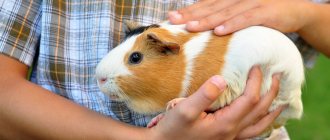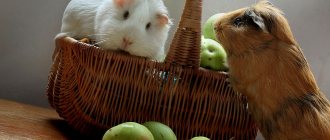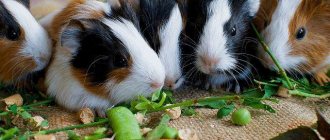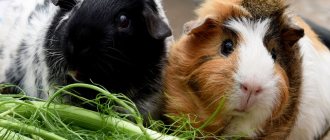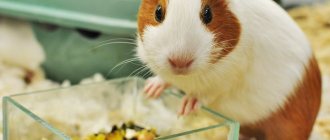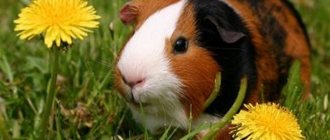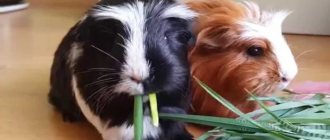As green food, you can offer tops of beets, carrots, cultivated peas and beans. Branches of fruit trees are very useful: apple and pear trees. You can give birch and aspen branches. From spring to late autumn, it is necessary to provide grass: sedge, sow thistle, clover, dandelions, nettles, mouse peas, and field herbs. There must be constant access to clean drinking water. Milk cannot replace water. From time to time you can offer a decoction of rosehip or nettle. Vitamin C (approximately 16 mg) is added to the diet daily, added to water or sprinkled on vegetables. ..
In order for a guinea pig to grind down its incisors, there should always be tree branches in its cage. Branches of apple, pear, birch, alder, and willow trees are suitable for this. However, not all tree branches are suitable for this. For example, it is not recommended to give plum and cherry twigs, as they contain hydrocyanic acid and tannins. Lilac, Thuja and Yew are also poisonous to them. .
You cannot give: meat, fish, poultry, sweet, salty, fried, spicy, smoked, confectionery and dairy products. Lilac branches are poison.
Guinea pigs are one of the most popular pets. Caring for them is quite easy, and even a schoolchild can cope with this task.
The pigs' cage is cleaned 1-2 times a week, and compressed sawdust, wood shavings or cat litter are poured onto the floor.
What should you feed your guinea pig so that it lives out its life healthy, playful and happy?
The main food of guinea pigs is hay . It must be in the cage at all times. Hay normalizes the functioning of the animal’s gastrointestinal tract. Together with the hard grain , it helps the pig wear down its teeth. Guinea pigs are rodents; their teeth grow throughout their lives. If the incisors are not allowed to wear down, they grow so large that they prevent the animal from closing its mouth and chewing, which can lead to illness and death of the pig.
You can buy hay at the store or make it yourself. If the hay has darkened, acquired an unpleasant odor or become damp, then you should not feed it to animals. It is better to throw away such hay and not even use it as bedding: after all, the pig can eat it and get poisoned.
Photo: pixabay.com
Pigs can be fed many types of herbs : dandelion, plantain, clover, nettle, alfalfa, chamomile, yarrow, knotweed (popularly known as knotweed), spinach, meadow chin, sweet clover, mouse pea, mantle, meadowsweet, mallow, fireweed, tansy, wormwood, bluegrass, peas, seradella, soybeans, vetch, china, sunflower, corn, sorghum, sudanese, millet, oats, quinoa. Spicy herbs that pigs eat well include parsley, dill, and celery.
But parsley is contraindicated for pregnant pigs.
All herbs can be given both fresh and dried.
The following herbs are strictly contraindicated for pigs: anemone, lumbago, poisonous and burning buttercups, marsh marigold, larkspur, chistyakov, wrestler, poppy, celandine, mustard, field radish, cockle, poisonous wedge, hemlock, marigold, datura, belladonna, nightshade, henbane , hellebore, arannik, whitewing, lily of the valley, raven's eye, colchicum, St. John's wort, comfrey, chickweed, grass grass, autumn colchicum (meadow wintergreen), poisonous wech, spurge, foxglove, lumbago, wild radish.
If you are not sure of identifying the type of grass, then it is better not to risk the health or even the life of your pet - you should not offer him an unknown or dubious plant.
Pigs gnaw tree branches : acacia, hazel, aspen, willow, birch, oak, alder, maple and poplar, as well as branches of fruit trees.
Apricot, cherry and lilac branches are poisonous to most animals.
It is unacceptable to use only green food in caring for an animal: it upsets the stomach.
From succulent food, pigs are fed vegetables, fruits and berries: carrots, cabbage (in small quantities, to avoid digestive upset), cucumbers (only in the summer, non-greenhouse), lettuce, zucchini, pumpkin, bell peppers, beets ( if possible, give your pigs feed varieties, although a little beetroot won't hurt either), a small piece of fresh potatoes, apples and pears. Pears should be fed with caution and little by little to avoid constipation. It is better to offer them dried berries: rose hips, blueberries, black currants.
There should always be grain in the feeder - whole, of high quality, with a pleasant smell, without mustiness or mold. Feeding grain infected with fungi can lead to the death of the pig. Many types of grain mixtures are sold in stores. As a rule, dried fruits and vegetables and herbal granules are mixed with them. Not all pigs eat pellets, especially if their diet includes complete grass and hay. You can determine which grains your pig likes more than others and prepare the mixture yourself, taking into account your pet’s tastes.
Photo: pixabay.com
Wheat, rye, rice, oats, barley, buckwheat, corn, sorghum, and millet can be fed whole. Legumes (peas, beans, soybeans, vetch, lentils) - crushed. Large corn grains can also be crushed or crushed so that the animal does not choke.
Water must be in the cage at all times! Even slight dehydration can lead to illness. In the cold season, to maintain the animal’s immunity, you can add ascorbic acid - vitamin C - to the water. The body is designed in such a way that it does not produce this vitamin itself, so it needs to receive it from the outside. The water in the drinking bowl should be changed daily.
Can a guinea pig eat lilacs?
Under no circumstances should you think of giving lilac branches to your guinea pig - they are poison! ... It is quite possible that some of them will be harmful or even fatal to the pig.
Interesting materials:
What holidays will there be in September? What were the taxes in the Soviet Union? What are the types of block diagrams? What styles of dresses are there? What are the origins of phraseological units? What are the types of voiceless consonants? What are the graphical forms of presenting information? What are the intonations in poetry? What types of khinkali are there? What types of bed linen sets are there?
What kind of grass can you give?
The list of acceptable herbs for guinea pigs is quite wide; pets will not suffer from a shortage.
All herbs should be collected from clean lawns and forests away from roads and industrial enterprises.
Dandelion
The leaves and roots of the plant are suitable for feeding the guinea pig. The leaves contain carotenoids and vitamins: C, groups B and P. The roots contain glucose and inulin. Dandelion helps improve blood circulation, gastrointestinal function, and increases appetite. It is better to give it fresh; it is permissible to prepare it in the form of hay for the winter. Only the green part of the plant is used as food; flowers should not be given to animals.
Plantain
A good remedy for normalizing blood glucose. Young leaves are added to your pet's diet - they are rich in potassium, contain carotene, enzymes and glycosides.
Clover
Ripe red and white clover plants are prepared for guinea pigs. Young grass can be given, but with caution, it can cause gastrointestinal upset.
You need to be careful when feeding a pregnant guinea pig; a large amount of clover in your pet's diet can cause a miscarriage.
Quinoa
Animals love this grass. But you don’t need to get carried away with it: quinoa contains acid, the excess of which leads to urolithiasis. It should be included in the diet in moderation.
Common borer
The grass is harmless to your pet and is given without fear throughout the season.
Chamomile
Chamomile is a natural antibiotic that helps cope with inflammation, relieves spasms, bloating, soothes and relieves pain. For gastrointestinal disorders, you can prepare a decoction of chamomile and feed it to your guinea pig.
Burdock
You can add burdock roots and leaves collected in spring and summer to your pet’s diet. Burdock is especially useful for diabetic animals due to its inulin content, which acts as a prebiotic, improving the functioning of the gastrointestinal tract.
Burdock has a laxative and diuretic effect. If the animal does not suffer from constipation, then this plant is introduced into the diet in small quantities.
Alfalfa
A nutritious plant for pregnant and lactating guinea pigs, as well as for growing young animals. Alfalfa contains a lot of calcium, which is why adult rodents should limit it.
Coltsfoot
In moderate quantities it will help with gastrointestinal problems and infectious diseases. Can be given as a decoction, or fresh or dried leaves. If given too much, coltsfoot can cause digestive upset.
Woodlice or chickweed
Relieves inflammation, normalizes blood pressure, and has moderate diuretic and choleretic properties. There are no contraindications to introducing woodlice into a guinea pig's diet, but it is recommended to offer it in moderation.
Common wormwood
It is well accepted by guinea pigs; fresh twigs can be given all summer, and hay can be stored for the winter. On the contrary, it is better to minimize bitter wormwood in the diet.
Sedge
This is a favorite treat for animals. And the most harmless thing: sedge can be given to guinea pigs in unlimited quantities and at any time of the year.
Wheatgrass
Like sedge, it is considered a favorite plant. It can be given fresh or made into hay.
Yarrow
Useful for kidney and urinary tract diseases, helps increase appetite. For prevention, it is recommended to include it in small quantities in the daily diet.
Nettle
To feed your guinea pig, it is better to use young nettle leaves before flowering. After flowering, the amount of nutrients decreases significantly. It is also better to collect leaves for hay before the plant matures. If it is not possible to collect nettles, you can use pharmaceutical preparations of leaves.
To prevent the nettle from burning your pet, it must be doused with boiling water before serving; the leaves will become softer and will not prick.
Mint
There are no contraindications for mint to be consumed by guinea pigs. It's more a matter of taste: some pets happily gobble up the fragrant leaves, others don't like it at all. It is recommended to include it in the diet in small quantities.
What grass and greens are prohibited
Plants that should absolutely not be given to guinea pigs:
- Rhubarb. Contains a lot of oxalic acid, which has a bad effect on kidney function. Because of this, stones can form in them and inflammatory processes can develop.
- Spurge. All types of milkweed are poisonous. After eating such complementary food, a guinea pig may experience convulsions, cardiac arrest, and the bitterness of milkweed juice leads to inflammation of the mucous membranes.
- Sorrel. Contains a lot of acid, which irritates the mucous membranes and stomach walls and can cause kidney disease.
- Avran. Causes stool upset and vomiting, leading to inflammation of the gastrointestinal tract.
- Winter meadow. It hits the blood vessels. Guinea pigs experience lethargy, heavy salivation, loose stools with blood, bloating, and a drop in temperature. If a large amount of grass is consumed, the animal dies.
- Whitewing. When eating berries, profuse salivation begins, tachycardia appears, and the animal begins to behave restlessly.
- Hemlock. After consuming the grass, the guinea pig's breathing and heart rate increase, convulsions and numbness in the limbs appear, and the temperature decreases.
- Fighter, aconite and other buttercups. The poison of these plants causes diarrhea, salivation, decreased blood pressure and body temperature. The animal begins to experience shortness of breath, and its behavior becomes violent.
- Celandine. Leads to burns of the mucous membranes, which is accompanied by weakness, gastrointestinal upset, and bloating.
- Cicuta. A plant that leads to rapid paralysis and death of the animal. When it gets into the animal's food, severe salivation, bloating and diarrhea begin, breathing and pulse quicken.
- Hellebore. Leads to convulsions, tremors, causes diarrhea and drooling. Breathing disturbances are observed.
- Wild mustard. Essential oils of the plant cause burns to the mucous membranes and respiratory organs, and affect the mucous membranes of the gastrointestinal tract.
- Bitter radish. Essential oils are also dangerous for animals. They burn the oral cavity, nasopharynx and gastrointestinal tract.
- Datura causes paralysis of the heart and legs.
- Digitalis. Leads to inflammation of the gastrointestinal tract, which is accompanied by diarrhea, bloating and vomiting. Shortness of breath, tachycardia and convulsions may occur.
- Cornflowers can cause colic, diarrhea and vomiting. When eating a large amount, paralysis occurs.
Grass and greens must be included in the daily diet of guinea pigs. Not so much because of the content of useful microelements in them, but because of the coarse fiber, which is the basis of nutrition for all herbivores. But not every herb is harmless to animals; some plants can cause serious illness or even death of an animal. When collecting grass and making hay yourself, it is important to study each plant so that noxious weeds do not get into the food.
What kind of greens can you give?
To diversify a guinea pig's diet, it includes not only healthy herbs, but also greens from the garden.
Lettuce leaves
Lettuce contains potassium, calcium and iron, which are important for keeping your pet healthy. At the same time, you should not give a lot of lettuce to guinea pigs with diabetes, as the leaves contain a lot of sugar.
Fresh salad is on the menu all year round. Greens grow quickly and are easy to grow on a windowsill.
Cilantro
Despite its strong aroma, cilantro is especially popular with guinea pigs. It does not contain harmful substances, so you can give it to your pet in unlimited quantities.
Green onions
It is permissible to feed only in small quantities. Green onions contain phytoncides that can irritate the stomach walls.
Spinach
A source of proteins and vitamins, it also contains minerals such as calcium, phosphorus, iron salts, potassium. Spinach is suitable for feeding guinea pigs in any form: fresh, frozen or dried. But only young leaves can be used.
Celery
One of the products that contains little sugar. This allows you to safely feed celery to diabetic guinea pigs. Both roots and leaves are beneficial for pets.
Parsley
Useful for young offspring and during the molting period. It is also recommended as an immunostimulant after illnesses.
Dill
Dill should be administered during pregnancy and lactation. It improves the nutritional properties of milk and helps increase its quantity.
Arugula
Acceptable in small quantities, but it should not be the first food for a guinea pig. Arugula contains mustard oil and accumulates a lot of nitrates in its leaves, which can be dangerous for young and pregnant pets.
Iceberg lettuce
Salad in large quantities can cause bloating. It is better to reduce the addition of greens to the diet to a minimum.
Green feed
Not all green foods are created equal for pigs. Many novice breeders wonder whether guinea pigs can have one or another type of succulent green food.
The list of permitted green feeds is quite large and includes:
- Grass (field grass or meadow grass is suitable), Carrots (rich in vitamin C), Apples, Dill, parsley, lettuce, Cauliflower, Cabbage leaves, Curled chicory, Parsley, Cilantro, Celery, Spinach, Birch twigs, Green beans or peas, any sweet pepper, Brussels sprouts, watermelons, fodder beets, red beets with tops, cucumbers, dandelions, garden sow thistle, shepherd's purse, sowing peas, plantain leaves, yarrow leaves, coltsfoot, ground pear, cobs and greens of young corn, Coriander.
In addition, guinea pigs can be given clover and alfalfa, vetch, lupins, sweet clover and winter rye or oats, and ryegrass.
Poisonous plants
When going to collect herbs for your beloved pet, you need to remember that there are a number of poisonous plants that not only cause poisoning, but also lead to death.
Plants that are poisonous and dangerous to guinea pigs include:
- Fighter, Arum, White acacia, Common aloe, Common and lemon geranium, All types of ferns, All types of lilies, Sorrel, Nightshade, Henbane, Lilies of the valley, All varieties of narcissus, Hyacinths, Celandine.
The following are considered dangerous for animals:
- Bay leaf, Gorse, All types of wisteria, Yew, All types of ivy, Derain, Common broom, Dogwood and all types of honeysuckle.
It is strictly forbidden to feed the following tree species:
- Twigs of thuja and oleander, Privet, Shoots and roots of juniper, Berries, leaves and twigs of elderberry, Mistletoe, Leaves, shoots and twigs of hellebore and belladonna.
Do they produce leaves?
Young branches are covered with leaves until autumn, which allows them to be included in your pet’s menu during the spring and summer. The leaves of the trees are juicy and aromatic, so they will be a healthy and tasty addition to a rodent’s diet.
Along with greens, you can pamper your pet with branches of those plants that are allowed in the animal’s diet. It is also separately allowed to offer the animal birch (along with buds), willow, linden, and maple leaves. The listed components of the diet are offered to the rodent without restrictions, that is, placed in a cage, without controlling how much raw material the pet will eat.
When preparing plant materials for a rodent, you need to choose only healthy trees that are located away from the roadway and industrial facilities. Before giving a sprig of greens to an animal, it must be washed and air dried. For the winter, the owner is recommended to make a supply of plant food by washing and drying the collected preparations for several months in the open air.
Source
Twigs
Twigs ¶
From: Svinni - April 12, 2007 0:17
Good evening! I read that pigs should be given twigs to chew on. And what branches can they use (which trees or bushes) Thanks in advance
Twigs ¶
From: Mystery - April 12, 2007 3:14 am
Good evening! I read that pigs should be given twigs to chew on. And what branches can they use (which trees or bushes) Thanks in advance. Apple trees can definitely be used, probably plums and cherries, but I know for sure lilacs can’t. In any case, I gave exactly these and everything was fine.
Twigs ¶
From: Lanka.zp - April 12, 2007 3:57 am
There are a lot of topics on the forum about branches, but what to do with leaves? I read that apple, currant, raspberry, etc. branches are given with foliage. But what about willow, birch, I don’t mean fruit trees? Today I cut a bunch of branches, I’m sitting, thinking whether to pick off the leaves or leave them - this is our first spring, we have no experience in such things.
Twigs ¶
From: Galina - April 12, 2007 4:54 am
You can: birch, ash, maple, apple tree (dry the branches), alder, pear, willow (all types), rowan, linden. They can be given to the pig “for free use.”
Avoid: tree branches that have seeds in their fruit, i.e. apricot, peach, cherry, plum, etc. (because if they have not been dried for at least 6 months, they may contain cyanogen glucosides, which cause intoxication); branches of coniferous trees; citrus branches like orange, lemon, tangerine, etc. (contain limonin).
Twigs ¶
From: Lanka.zp - April 13, 2007 2:27 am
You can: birch, ash, maple, apple tree (dry the branches), alder, pear, willow (all types), rowan, linden. You can put them “for free use” by the pig. “For free use” does this mean both branches and leaves?
Twigs ¶
From: Galina - April 13, 2007 5:45 am
For free use - this means that the twigs (with or without leaves) can always be at the disposal of the pigs, they do not need to be limited. Here’s another example for you, a statement from the forum: My pigs get plenty of hard feed and their bite is fine. In the summer, I stocked up on apple branches with leaves (one of my favorite treats) as an additional diet; in addition to the leaves, she also eats branches, nibbles them off and eats them, chewing them thoroughly.
Twigs ¶
From: Svinni - April 13, 2007 2:45 pm
Can pigs have cherry branches and leaves? And I didn’t quite understand something, can I have imiren or not?
Twigs ¶
From: Galina - April 14, 2007 0:49
Can pigs have cherry branches and leaves? And I didn’t quite understand something, can I have imiren or not? I don't know anything about lilacs. The only thing I can say is that I have never seen a single animal that would eat it, and I have never even seen caterpillars on it. Cherry branches may contain the same substance as the fruits inside in the pits - albeit in smaller quantities, and it is toxic. That’s why it is recommended to dry cherry branches (and all fruit trees with seeds) for six months before giving them to the pig.
Twigs ¶
From: L_enok - April 14, 2007 2:50
